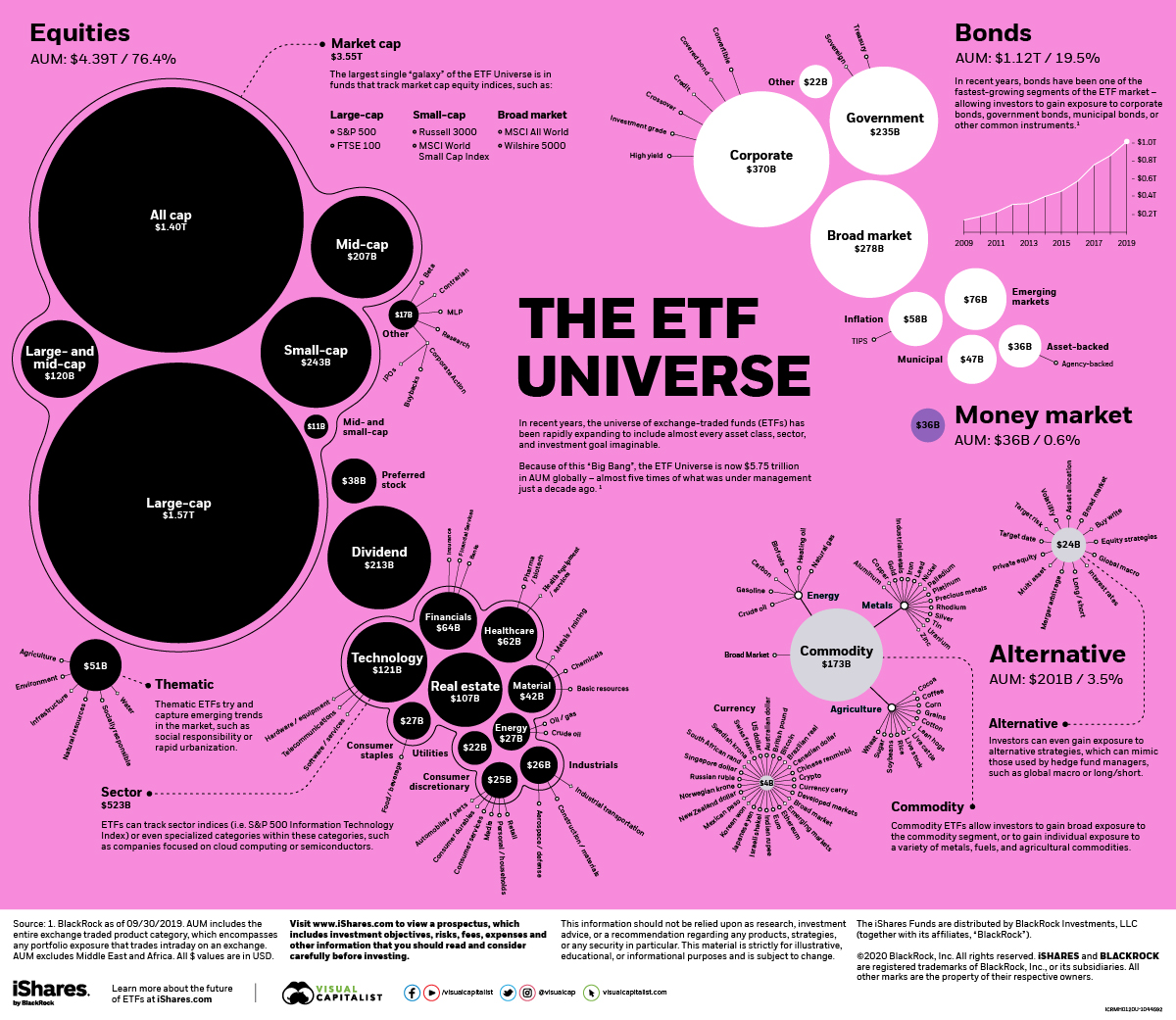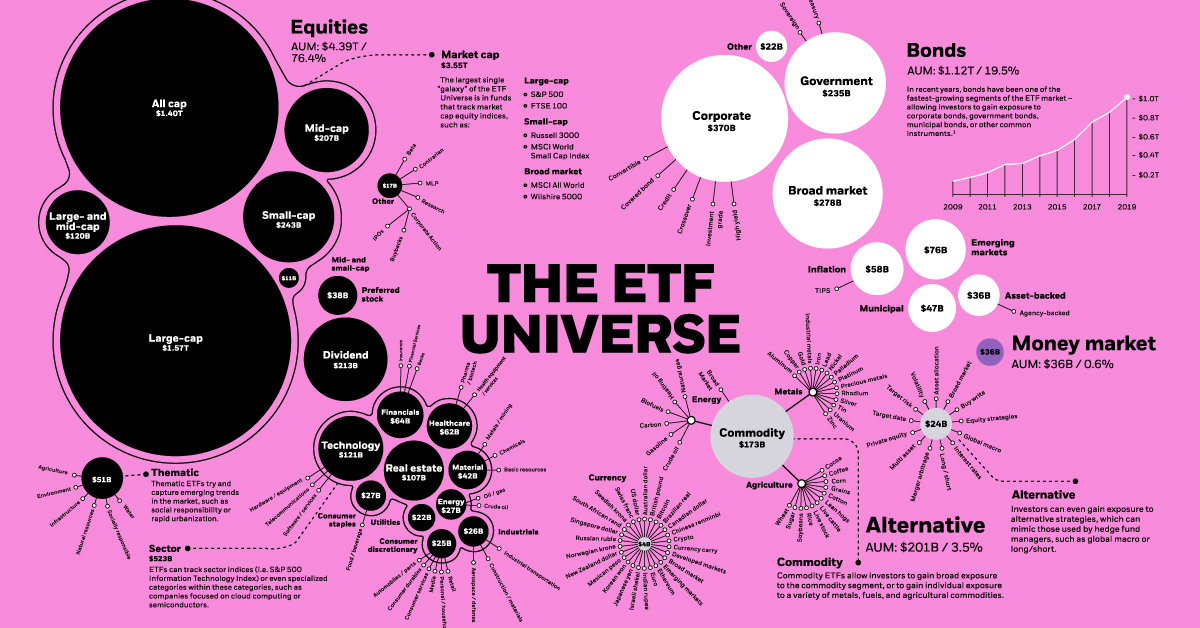Markets
Visualizing the Expanse of the ETF Universe
View the full-size version of this infographic.
Visualizing the Expanse of the ETF Universe
View the high resolution version of this infographic by clicking here.
Under the right circumstances, an innovation can scale and flourish.
Within the financial realm, there is perhaps no better example of this than the introduction of exchange-traded funds (ETFs), a new financial technology that emerged out of the index investing phenomenon of the early 1990s.
Since the establishment of the first U.S. ETF in 1993, the financial instrument has gained broad traction — and today, the ETF universe has an astonishing $5.75 trillion in assets under management (AUM), covering almost every niche imaginable.
Navigating the ETF Universe
Today’s data visualization comes to us from iShares by BlackRock, and it visualizes the wide scope of assets covered by the ETF universe.
To start, let’s look at a macro breakdown of the “galaxies” that can be found in the universe:
| Global ETFs (AUM, $USD) | Share of Global Total | |
|---|---|---|
| Equities | $4.39 trillion | 76.4% |
| Bonds | $1.12 trillion | 19.5% |
| Alternative | $0.20 trillion | 3.5% |
| Money market | $0.04 trillion | 0.6% |
| All ETFs | $5.75 trillion | 100.00% |
As you can see, equities are by far the largest galaxy in the ETF universe, making up 76.4% of all assets. These clusters likely comprise the ETFs you are most familiar with — for example, funds that track the S&P 500 index or foreign markets.
That said, it’s worth noting that the fastest expanding galaxy is bond ETFs, tracking indices related to the debt issued by governments and corporations. The first bond ETFs were introduced in 2002, and since then the category has grown into a market that exceeds $1 trillion in AUM. Bond ETFs are expected to surpass the $2 trillion mark by 2024.
Everything Under the Sun
While the sheer scale of the ETF universe is captivating, it’s the variety that shows you how ubiquitous the instrument has become.
Today, there are over 8,000 ETFs globally, covering nearly every asset class imaginable. Here are some of the lesser-known and more peculiar corners in the ETF universe:
Thematic ETFs: Gaining popularity in recent years, thematic ETFs are built around long-term trends such as climate change or rapid urbanization. By having more tangible focus points, these funds can also appeal to younger generations of investors.
Contrarian ETFs: In a healthy market, there can be a variety of different positions being taken by investors. Contrarian ETFs help to make this possible, allowing investors to bet against the “herd”.
Factor-based ETFs: This approach uses a rules-based system for selecting investments in the fund portfolio, based on factors typically associated with higher returns such as value, small-caps, momentum, low volatility, quality, or yield.
Global Macro ETFs: Some ETFs are designed to mimic strategies used by hedge fund managers. One example of such a strategy is global macro, which aims to analyze the macroeconomic environment, while taking corresponding long and short positions in various equity, fixed income, currency, commodities, and futures markets.
Commodity ETFs: There are ETFs that track gold or oil, sometimes even storing physical inventories. Interestingly, however, there are commodity ETFs for even more obscure metals and agricultural products, such as zinc, lean hogs, tin, or cocoa beans.
Whether your investments track popular market indices or you are more surgical about your portfolio exposure, the ETF universe is impressively vast — and it’s projected to keep expanding in size and diversity for years to come.
Markets
The European Stock Market: Attractive Valuations Offer Opportunities
On average, the European stock market has valuations that are nearly 50% lower than U.S. valuations. But how can you access the market?

European Stock Market: Attractive Valuations Offer Opportunities
Europe is known for some established brands, from L’Oréal to Louis Vuitton. However, the European stock market offers additional opportunities that may be lesser known.
The above infographic, sponsored by STOXX, outlines why investors may want to consider European stocks.
Attractive Valuations
Compared to most North American and Asian markets, European stocks offer lower or comparable valuations.
| Index | Price-to-Earnings Ratio | Price-to-Book Ratio |
|---|---|---|
| EURO STOXX 50 | 14.9 | 2.2 |
| STOXX Europe 600 | 14.4 | 2 |
| U.S. | 25.9 | 4.7 |
| Canada | 16.1 | 1.8 |
| Japan | 15.4 | 1.6 |
| Asia Pacific ex. China | 17.1 | 1.8 |
Data as of February 29, 2024. See graphic for full index names. Ratios based on trailing 12 month financials. The price to earnings ratio excludes companies with negative earnings.
On average, European valuations are nearly 50% lower than U.S. valuations, potentially offering an affordable entry point for investors.
Research also shows that lower price ratios have historically led to higher long-term returns.
Market Movements Not Closely Connected
Over the last decade, the European stock market had low-to-moderate correlation with North American and Asian equities.
The below chart shows correlations from February 2014 to February 2024. A value closer to zero indicates low correlation, while a value of one would indicate that two regions are moving in perfect unison.
| EURO STOXX 50 | STOXX EUROPE 600 | U.S. | Canada | Japan | Asia Pacific ex. China |
|
|---|---|---|---|---|---|---|
| EURO STOXX 50 | 1.00 | 0.97 | 0.55 | 0.67 | 0.24 | 0.43 |
| STOXX EUROPE 600 | 1.00 | 0.56 | 0.71 | 0.28 | 0.48 | |
| U.S. | 1.00 | 0.73 | 0.12 | 0.25 | ||
| Canada | 1.00 | 0.22 | 0.40 | |||
| Japan | 1.00 | 0.88 | ||||
| Asia Pacific ex. China | 1.00 |
Data is based on daily USD returns.
European equities had relatively independent market movements from North American and Asian markets. One contributing factor could be the differing sector weights in each market. For instance, technology makes up a quarter of the U.S. market, but health care and industrials dominate the broader European market.
Ultimately, European equities can enhance portfolio diversification and have the potential to mitigate risk for investors.
Tracking the Market
For investors interested in European equities, STOXX offers a variety of flagship indices:
| Index | Description | Market Cap |
|---|---|---|
| STOXX Europe 600 | Pan-regional, broad market | €10.5T |
| STOXX Developed Europe | Pan-regional, broad-market | €9.9T |
| STOXX Europe 600 ESG-X | Pan-regional, broad market, sustainability focus | €9.7T |
| STOXX Europe 50 | Pan-regional, blue-chip | €5.1T |
| EURO STOXX 50 | Eurozone, blue-chip | €3.5T |
Data is as of February 29, 2024. Market cap is free float, which represents the shares that are readily available for public trading on stock exchanges.
The EURO STOXX 50 tracks the Eurozone’s biggest and most traded companies. It also underlies one of the world’s largest ranges of ETFs and mutual funds. As of November 2023, there were €27.3 billion in ETFs and €23.5B in mutual fund assets under management tracking the index.
“For the past 25 years, the EURO STOXX 50 has served as an accurate, reliable and tradable representation of the Eurozone equity market.”
— Axel Lomholt, General Manager at STOXX
Partnering with STOXX to Track the European Stock Market
Are you interested in European equities? STOXX can be a valuable partner:
- Comprehensive, liquid and investable ecosystem
- European heritage, global reach
- Highly sophisticated customization capabilities
- Open architecture approach to using data
- Close partnerships with clients
- Part of ISS STOXX and Deutsche Börse Group
With a full suite of indices, STOXX can help you benchmark against the European stock market.

Learn how STOXX’s European indices offer liquid and effective market access.

-

 Economy3 days ago
Economy3 days agoEconomic Growth Forecasts for G7 and BRICS Countries in 2024
The IMF has released its economic growth forecasts for 2024. How do the G7 and BRICS countries compare?
-

 Markets2 weeks ago
Markets2 weeks agoU.S. Debt Interest Payments Reach $1 Trillion
U.S. debt interest payments have surged past the $1 trillion dollar mark, amid high interest rates and an ever-expanding debt burden.
-

 United States2 weeks ago
United States2 weeks agoRanked: The Largest U.S. Corporations by Number of Employees
We visualized the top U.S. companies by employees, revealing the massive scale of retailers like Walmart, Target, and Home Depot.
-

 Markets2 weeks ago
Markets2 weeks agoThe Top 10 States by Real GDP Growth in 2023
This graphic shows the states with the highest real GDP growth rate in 2023, largely propelled by the oil and gas boom.
-

 Markets3 weeks ago
Markets3 weeks agoRanked: The World’s Top Flight Routes, by Revenue
In this graphic, we show the highest earning flight routes globally as air travel continued to rebound in 2023.
-

 Markets3 weeks ago
Markets3 weeks agoRanked: The Most Valuable Housing Markets in America
The U.S. residential real estate market is worth a staggering $47.5 trillion. Here are the most valuable housing markets in the country.
-

 Science1 week ago
Science1 week agoVisualizing the Average Lifespans of Mammals
-

 Markets2 weeks ago
Markets2 weeks agoThe Top 10 States by Real GDP Growth in 2023
-

 Demographics2 weeks ago
Demographics2 weeks agoThe Smallest Gender Wage Gaps in OECD Countries
-

 United States2 weeks ago
United States2 weeks agoWhere U.S. Inflation Hit the Hardest in March 2024
-

 Green2 weeks ago
Green2 weeks agoTop Countries By Forest Growth Since 2001
-

 United States2 weeks ago
United States2 weeks agoRanked: The Largest U.S. Corporations by Number of Employees
-

 Maps2 weeks ago
Maps2 weeks agoThe Largest Earthquakes in the New York Area (1970-2024)
-

 Green2 weeks ago
Green2 weeks agoRanked: The Countries With the Most Air Pollution in 2023
















